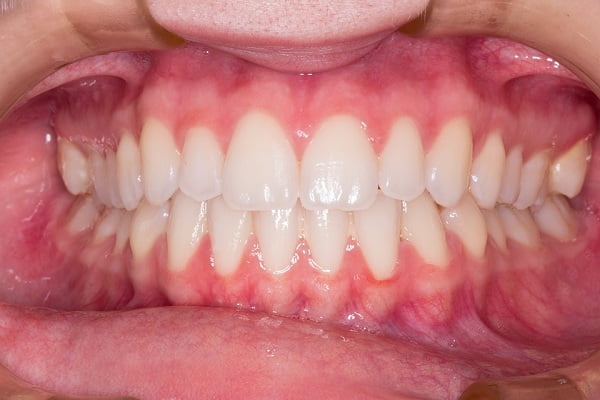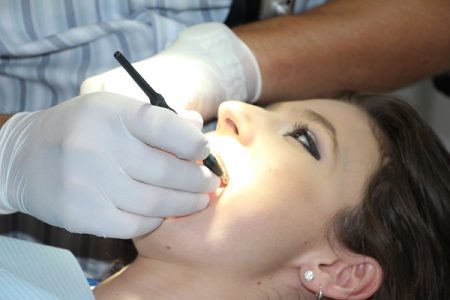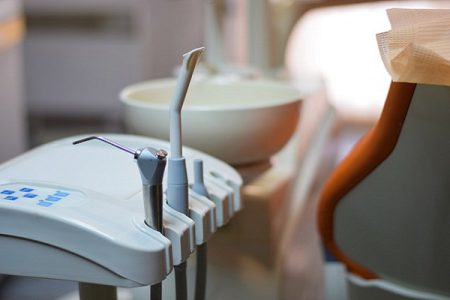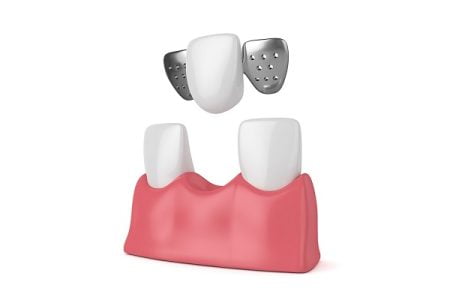Impacted Tooth (Tooth Impaction): Causes, Symptoms, Treatment, Diagnosis
- Updated on: Jul 11, 2024
- 7 min Read
- Published on Apr 12, 2019


Definition and Meaning: What is an impacted tooth?
Impaction is when a tooth has simply failed to erupt through the gum at the expected time i.e. the eruption schedule (in reference to the tooth chart). This unerupted tooth is called the impacted tooth. The impacted tooth might face difficulty in coming out due to lack of space between the teeth or the tooth might have grown in a wrong direction or position.
Impacted teeth are generally maxillary canines or mandibular premolars. Impacted tooth is often painless and its presence cannot be detected until it begins to erupt. Sometimes, the part of gum which covers the tooth can become swollen and infectious which might trigger pain in the surrounding area around the teeth or near the ear or on the face. This is known as impacted tooth pain and is one of the primary symptoms of impacted tooth.
Not commonly but sometimes, partial impaction can also be observed i.e. the tooth starts bulging out in small bits. The upper portion that bulges out as small edges, initially, is the soft tissue impaction that has penetrated through the bone whereas the hard portion or the bony impacted tooth is bound in the jawbone. Impacted tooth can also damage the teeth near it.
Tooth impaction can also be related to an unerupted tooth, which is in a partial stage of eruption and is a malposed tooth – either erupted or unerupted and is present in an abnormal position in the maxilla or in the mandible.
Classification of impacted tooth
Classification of impacted tooth helps to detect severity of the problem and allows dentists to determine position of the impacted tooth and plan for treatment or impacted tooth surgery. These positions that describe the impaction in the tooth are mesial, distal, horizontal, vertical, soft-tissue and bony impacted tooth.
Classification is based on the radiographic analysis. For radiographic analysis, different types of radiographs are used such as:
- Intraoral periapical radiograph
- Lateral jaw radiograph
- Occlusal radiograph
- Panoramic radiograph
Classification of the impacted tooth depends on certain features, such as:
- Crowning position of the tooth
- Character or nature of root formation
- The type of bone present near the root
- Position and relation between adjacent molars
Impacted tooth classification can be done in three ways:
Winter classification
Winter classification depends on angulation of tooth, such as:
- Vertical angle of the tooth means that it is parallel to long axis of the second molar
- Mesioangular means that the tooth is inclined mesially
- Horizontal/traverse/inverted forms the right angle or reverse angles
- Distoangular is distal inclination of the impacted tooth
- Linguoangular is when the occulusal surface faces the tongue
- Buccoangular is the occulusal facing cheek
Pell’s and Gregory’s classification
Pell’s and Gregory’s classification depends on the relationship of third molar to ramus (nerve) of mandible and to second molar. It is mainly dependent on the area of the impacted tooth that is covered near the mandibular ramus. It is distinguished into three classes:
Class 1: In case 1, ample amount of required space is present between ramus and distal side of second molar. This space is to accommodate mexiodistal diameter of the crown of the third molar.
Class 2: In case 2, there is a lack of space between mexiodistal diameter of the crown of third molar and ramus and distal side of the second molar.
Class 3: The tooth is located within the ramus in case 3.
Classification of the impacted tooth also depends on the relative depth of the tooth:
- Position A of the impacted tooth defines the topmost position of the tooth on the same level or above occlusal line.
- Position B of the impacted tooth states the peak position of the tooth above the cervical level of second molar and below the occlusal line.
- Position C of the impacted tooth is the utmost position of the tooth below the cervical plane.
Maxillary classification:
Maxillary classification depends on the relation of the tooth to the floor of maxillary sinus.
In molars, either of the two conditions prevails:
- A very emaciated bony partition might be present between impacted maxillary third molar and the floor of maxillary sinus. Although, this is not mandatory, the bony partition can be absent as well. This condition is called Sinus Approximation.
- The size of the bone might be 2mm or more between impacted maxillary third molar and the floor of maxillary sinus. This is termed as Non Sinus Approximation.
More: Signs and Symptoms of Periodontal Disease (Gum Disease)
More: Missing Front Teeth, Chipping Of Front Teeth and Its Replacement
In canines, the classification is done according to the position of the impacted tooth:
Class 1: Palatally placed (i.e. placed on the side of tooth adjacent to the palate) maxillary canine in horizontal, vertical or semi-vertical position.
Class 2: Labially or buccally (i.e. placed in the side of a tooth which adjacent to the inside of the lip or cheek) placed in horizontal, vertical or semi-vertical position
Class 3: This class involves both palatal and buccal position of the bone
Class 4: The tooth is impacted in the alveolar process between premolar and incisors.
Class 5: Impacted in edentulous maxilla.
Complications related to an impacted tooth
A partially impacted tooth is more difficult to handle than an unerupted tooth. Partially erupted tooth is more prone to risk for dental problems as it is exposed. A few problems or complications related to the impacted tooth are listed below:
- Periodontal disease might occur on the neighboring tooth
- Plaque formation is observed between teeth and gums
- Nerve damage might occur. This happens if the impacted tooth is close to a nerve in the jaw called the mandibular nerve.
- Alignment of the teeth (known as malocclusion) is poor
- Chronic pain and discomfort in the mouth
- Crowding of nearby teeth
- Abscess in gums
- Cysts might occur which may damage roots of nearby teeth or gum area
- Absorption of bone or adjacent teeth
- Infection or gum disease (pericoronitis)
- Cavity and decay (dental caries)
More: Tooth Loss (Edentulism): Causes, Prevention, Complications, Treatment
More: Home Remedies for Tooth Decay (Dental Cavity)
Signs and symptoms of tooth impaction
Commonly noticed impacted tooth symptoms and signs are:
- Redness and swelling in gums in the back of the mouth
- Tenderness and bleeding in gums
- Pain in jaw
- Paraesthesia of lip
- Occasional difficulty in opening the mouth
- Bad breath and unpleasant taste
- Pain when chewing or biting
- Visible gap where a tooth did not emerge
- Severe headaches, sometimes.
Wisdom impacted tooth or impacted molar or impacted third molar many a times do not show any sign and symptom but is more prone to infections, tooth decay, gum problems, etc because molars are hard to clean.
See also: Bad Breath Prevention: How to Get Rid of Bad Breath (Halitosis)?
See also: Treatment Options and Home Remedies for Bad Breath (Halitosis)
If you note any of the above signs and symptoms of impacted tooth, you should contact a dentist to check if the symptoms are caused by the impacted tooth. It is easier to treat impacted tooth symptoms when reported earlier.
Causes of tooth impaction
The main and most common cause of tooth impaction (cause of impacted tooth) is that there is not enough room between the teeth for the tooth to fully emerge out.
Impaction can also occur due to displacement of the tooth. The tooth is observed to erupt out at wrong angle and leads to partial eruption.
Some common causes of impacted tooth are listed below:
- Premature loss of primary teeth is an important cause of impacted tooth
- Long retention of primary teeth is another cause of tooth impaction
- Surgical repositioning can cause impacted tooth
- Lack of space or increased density due to surrounding bone or non absorption of alveolar bone
- Presence of soft tissues or bony lesions
- Any obstruction such as cell fibromatosis, compact bone, presence of supernumery tooth, scar tissue, ectopic position of tooth bud, etc during eruption are also potential causes of impaction of tooth.
- Inflammation which can increase the density of overlying mucous membrane can cause development of impacted tooth
- Diseases such as neurosis, or any other infections, anemia, rickets, endocrine dysfunction or malnutrition can also trigger impaction
- Hereditary linked disorders can also affect tooth impaction
- A few rare conditions such as progeria, cleft plate, osteoporosis, oxycephaly, cleidocranial dysostrosis, etc are rare causes of tooth impaction.
Diagnosis of impacted tooth
Depending on the symptoms of impacted tooth, tests and examinations are carried out to detect the exact problems in teeth set or in gum.
Mainly, dental X-rays are carried out to detect these issues and make a diagnosis of impacted tooth. Dental x-rays help to confirm whether there is any abnormality in the jaw and help in the diagnosis of impacted tooth. Sometimes, clinical assessment is necessary to confirm the diagnosis of impacted tooth
Treatment for impacted tooth
There are primarily four ways to manage and/or treat an impacted tooth:
Observation: In this case, there is no treatment given to the patient for a specific period.
Intervention: Orthodontic therapy is recommended for a small period or the tooth can also removed to eradicate tooth impaction
Relocation: The impacted tooth is allotted a new position orthodontically.
Extraction: The impacted tooth is removed completely.
After the diagnosis of impacted tooth through X-ray, the only reliable treatment for the impacted tooth is oral surgery through extraction carried out by a dentist (oral surgeon). It is a minor surgical procedure in which a small cut or incision is made in the gum and the tooth is removed by extracting it out.
The impacted tooth can be either broken into pieces or can also be removed as a single piece during extraction.
Extraction or impacted tooth surgery is a sensitive procedure and requires very careful examination of the mouth. This is done to detect the exact position and location where impaction has occurred.
Impaction also affects the nearby area; therefore extraction can lead to an adverse impact on the nerves, blood vessels and other structures present in the nearby areas. In case of a wisdom tooth, sometimes there might be no straight way to remove the impacted tooth, so it is supposed to be a complicated extraction.
During and after extraction of impacted 3rd molar, sometimes bleeding, swelling, an obvious discomfort and pain may occur in the jaw. Therefore, pain management becomes an important part of the treatment procedure.
Pain management in impacted tooth
- Pain killers or over-the-counter pain relievers such as aspirin reduce some level of pain and up to a moderate level caused due to the impacted tooth.
- Cold compresses are used to reduce swelling.
- Warm saltwater (3 grams of salt in 240 milliliters of water) or over-the-counter mouthwashes are prescribed for relaxing and soothing the gums.
- Antibiotics may be prescribed before the extraction if the tooth is infected.
Impaction might not be a serious problem in some cases and there is no need to treat them until and unless it causes any discomfort to the person. However, if any complication occurs, extraction is the most conservative and useful method. Sometimes, even if there are no complications, it is suggested that the extraction is carried out to prevent any damage to the nerves or infection in the surrounding area.
Routine dental checkups are necessary to maintain health of teeth.











